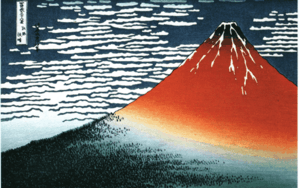Printmaking facts for kids
Printmaking is a cool way to make art by printing pictures, usually on paper. The best part about printmaking is that you can make many copies of the same picture. Each printed picture is called a "print." It's not just a copy, but an original artwork, because it comes from the same special source or plate, unlike a painting or drawing. There are many different ways to create these prints!
Contents
How Artists Make Prints
Main Printmaking Styles
Printmaking methods are usually put into these main groups:
- Relief printing: Here, the ink goes on the raised parts of the surface. Think of it like a rubber stamp! Examples are woodcut, linocut, and metalcut.
- Intaglio printing: For this, the ink sits in the carved-out lines or lower parts of the surface. Techniques include engraving, etching, mezzotint, and aquatint.
- Planographic printing: The surface stays flat, but special preparations make the image transfer. Lithography and monotyping are examples.
- Stencil printing: Ink or paint is pushed through a prepared screen. Screen printing is a common type.
Some other printmaking methods don't fit neatly into these groups, like collagraphy. Modern printmaking can also use digital printing or photos. Artists often mix these techniques, especially within the same family. For example, Rembrandt's prints, often called "etchings," sometimes also use engraving or drypoint.
Woodcut Prints
Albrecht Dürer, Hiroshige, Hokusai, Frans Masereel, Ernst Ludwig Kirchner, Eric Slater
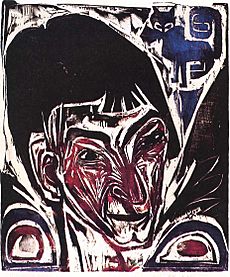
Woodcut is the oldest way to make prints. It was first used in China to print patterns on cloth, and by the 5th century, it was used for text and images on paper. Woodcuts became popular for art around 1400 in Japan and Europe.
To make a woodcut, the artist draws a design on a piece of wood. Then, a specialist carves away the parts of the wood that should NOT get ink. The raised parts are inked with a brayer (a roller). A sheet of paper is placed on top, and the artist rubs the back of the paper with a baren or spoon, or uses a printing press.
If you want to add color, you can use separate wood blocks for each color. Or, artists use a method called "reduction printing." This means using just one block. The artist cuts a little bit away, prints that color, then cuts more away, and prints the next color on top. This lets the first color show through. The cool thing is that all the colors line up perfectly. The downside is that once you cut more away, you can't make any more prints of the earlier colors.
Engraving
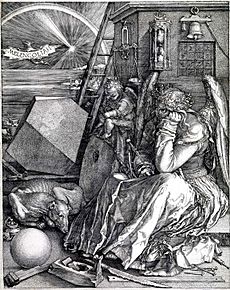
Engraving started in Germany in the 1430s. It came from the way goldsmiths decorated metal. Engravers use a sharp steel tool called a burin to cut their design into a metal plate, usually made of copper. Learning to use a burin well takes a lot of practice!
To make a print, the engraved plate is covered in ink. Then, the artist wipes the ink off the surface, so ink only stays in the cut lines. The plate and a piece of paper are then put through a high-pressure printing press. The paper picks up the ink from the lines, making the print. You can make hundreds of prints from one plate before it starts to wear out.
Etching
Etching is part of the intaglio family, like engraving. The first known etching was made by Albrecht Dürer in 1515. Etching quickly became very popular because it was easier to learn than engraving for artists who could already draw.
In etching, a metal plate (like copper or zinc) is covered with a waxy or acrylic coating. The artist draws through this coating with a pointed needle, exposing the metal underneath. Then, the plate is dipped into a special acid. The acid "bites" into the exposed metal, creating lines. After cleaning off the coating, the printing process is the same as for engraving. The ink fills the bitten lines, and the press transfers it to paper.
Mezzotint
Mezzotint is a type of intaglio printmaking where the image is made using subtle changes from light to dark. It's often called a "dark manner" printmaking because artists usually start with a dark surface and work towards lighter areas. To do this, the artist first roughens the entire surface of a copper plate evenly with a tool called a rocker. Then, they smooth out parts of the surface with a tool called a burnisher.
When ink is applied, the rough areas hold more ink and print darker. The smoother areas hold less or no ink, printing lighter or not at all. Mezzotint is famous for its rich, deep tones because the roughened surface holds a lot of ink. It also allows for very smooth changes in tone. This method was invented by Ludwig von Siegen in the 1600s.
Aquatint
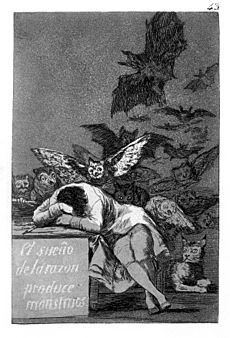
Aquatint is another technique used in intaglio etchings. Like etching, it uses acid to make marks on a metal plate. But instead of lines, aquatint creates tonal effects, like washes of color. This is done by dusting the plate with powdered rosin (a type of tree sap), which resists acid. The rosin is heated until it sticks to the plate.
The artist can then burnish or scratch the rosin to change how much acid touches the plate. The amount of acid exposure controls how dark or light large areas of the image will be. So, the image is shaped by large sections of tone. Goya used aquatint for many of his famous prints.
Drypoint
Drypoint is like engraving, but it uses a sharp point instead of a v-shaped burin. When the artist scratches the plate, it leaves a rough edge called a "burr" along each line. This burr gives drypoint prints a soft, sometimes blurry, line quality.
Because the burr gets worn down quickly during printing, drypoint prints can only be made in small numbers, maybe ten or twenty copies. To make more prints, artists sometimes harden the plate's surface using a process called steelfacing. The Housebook Master invented this technique in the 1400s. Albrecht Dürer and Rembrandt also used drypoint, often with etching and engraving.
Lithography
Honoré Daumier, Vincent van Gogh, Toulouse-Lautrec, Pablo Picasso, Salvador Dalí, M. C. Escher.
Lithography was invented in 1798 by Alois Senefelder. It works because oil and water don't mix. An artist draws on a flat, porous surface, usually limestone, with a greasy crayon or ink. Acid is then applied, which helps the grease stick to the stone. Next, Gum arabic, which dissolves in water, is put on the parts of the stone not covered by the drawing.
When the stone is wet, water only stays on the parts without grease. Then, oily ink is rolled over the stone. Because water pushes away oil, the ink only sticks to the greasy drawing. A dry sheet of paper is placed on the stone, and a printing press transfers the image. Lithography is great for showing fine details and smooth changes in shading.
A variation is photo-lithography, where the image is put onto metal plates using photography. The printing process is then the same.
Screenprinting
Josef Albers, Roy Lichtenstein, Julian Opie, Andy Warhol.
Screen printing (also called "silkscreen" or "serigraphy") uses a fabric stencil. Ink is pushed through the stencil onto the paper, often with a tool called a squeegee. The fabric, which can be silk or nylon, is stretched tightly over a frame.
Unlike many other printmaking methods, you don't need a printing press for screen printing. It's a very hands-on, "Do It Yourself" technique. Screen printing can be used on many different materials, like paper, cloth, canvas, rubber, glass, and metal. Artists have even used it to print on bottles or walls!
Monotype
Monotyping is a type of printmaking where you draw or paint on a smooth surface that doesn't soak up liquid, like a copper plate, zinc, or glass. The image is then transferred onto a sheet of paper by pressing them together, usually with a printing press. You can also make a monotype by covering the whole surface with ink and then removing ink with brushes or rags to create the image.
Unlike monoprinting, a monotype creates only one unique print. Most of the ink is removed during the first press. If you try to print again, it's called a "ghost print" and looks very different. Artists often use stencils, watercolors, or other tools to add to a monotype. Monotypes are often made quickly and without a detailed sketch. They are considered the most painterly printmaking method, like a printed painting.
Monoprint
Monoprinting is a type of printmaking that uses a main surface (like a woodblock or litho stone), but each print made from it is unique. If you make several unique prints from the same surface, it's sometimes called a "variable edition." There are many ways to make monoprints, including adding things like collage or hand-painted details. You can also change the type, color, or thickness of the ink to make different prints. Traditional printmaking methods like lithography and woodcut can be used to make monoprints.
Digital Prints
Istvan Horkay, Ralph Goings, Enrique Chagoya
Digital prints are images made using digital printers, like inkjet printers, instead of traditional printing presses. These images can be printed on many different materials, such as paper, cloth, or plastic.
Dye-Based Inks
Dye-based inks are made from organic (natural or human-made) colors dissolved in a liquid. They are great for fabrics because the dye soaks into the fibers. However, they are not as good for prints on paper because the ink layers are very thin and can fade more easily.
Pigment-Based Inks
Pigment-based inks use tiny, finely ground particles of color that are mixed into a liquid. These particles don't dissolve but stay spread out in the ink. Pigments can be from inorganic (mineral) or organic sources. Pigment-based inks last much longer and are less likely to fade than dye-based inks.
Giclée
Giclée (pronounced zhee-KLAY) is a name created in 1991 for digital prints made on inkjet printers. It first referred to prints made with dye-based inks, but now it usually means prints made with pigment-based inks. Today, high-quality art prints made on large inkjet machines are often called "Giclée."
Foil Imaging
In art, foil imaging is a printmaking method that uses gold leaf and acrylic foil. It was developed by Virginia A. Myers from a commercial process.
Adding Color to Prints
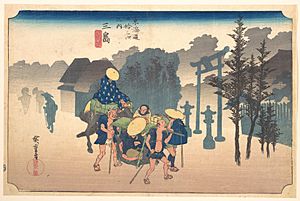
Printmakers use many ways to add color to their prints. Some methods include using separate plates, blocks, or screens for each color, or using a "reductionist" approach.
In methods with multiple plates, a different plate, screen, or block is made for each color. Each one is inked with a different color and printed in a specific order to create the full picture. Artists usually use three or four plates, but sometimes up to seven! The artist has to think about how each new color will mix with the colors already on the paper. Often, the lightest colors are printed first, then the darker ones.
The reductionist approach uses just one lino or wood block. The artist starts with a blank or simply etched block. After printing the first color, the artist cuts more material away from the block, then applies another color and prints again. Each time more material is removed, the previously printed color shows through. Pablo Picasso is often linked with reduction printmaking, though it was used before his time.
Images for kids
-
Katsushika Hokusai The Underwave off Kanagawa, 1829/1833, color woodcut
-
Rembrandt, Self-portrait, etching, around 1630
-
Francisco Goya, There is No One To Help Them, Disasters of War series, aquatint around 1810
-
Albrecht Dürer, Saint Jerome in his Study, 1514.
-
Rembrandt, Christ Preaching, (The Hundred Guilder print); etching around 1648
-
Rachel Robinson Elmer, halftone offset lithograph, Woolworth Building June Night, 1916
-
Paul Gauguin, Arearea no Varua Ino (Words of the Devil), watercolor monotype, 1894
See also
 In Spanish: Estampa para niños
In Spanish: Estampa para niños


